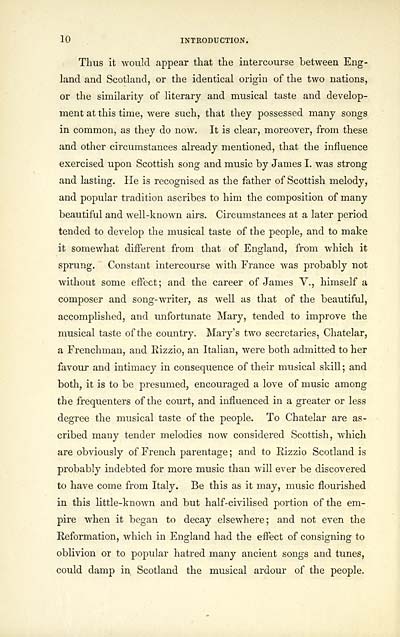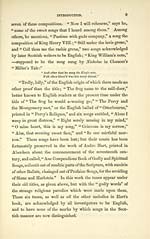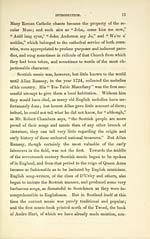Glen Collection of printed music > Printed text > Illustrated book of Scottish songs from the sixteenth to the nineteenth century
(26) Page 10
Download files
Complete book:
Individual page:
Thumbnail gallery: Grid view | List view

10 INTUODUCTIOK.
Tims it would appear that the intercourse between Eng-
land and Scotland, or the identical origin of the two nations,
or the similarity of literary and musical taste and develop-
ment at this time, were such, that they possessed many songs
in common, as they do now. It is clear, moreover, from these
and other circumstances already mentioned, that the influence
exercised upon Scottish song and music by James I. was strong
and lasting. He is recognised as the father of Scottish melody,
and popular tradition ascribes to him the composition of many
beautiful and well-known airs. Circumstances at a later period
tended to develop the musical taste of the people, and to make
it somewhat different from that of England, from which it
sprung. Constant intercourse with France was probably not
without some effect; and the career of James V., himself a
composer and song- writer, as well as that of the beautiful,
accomplished, and unfortunate Mary, tended to improve the
musical taste of the country. Mary's two secretaries, Chatelar,
a Frenchman, and Eizzio, an Italian, were both admitted to her
favour and intimacy in consequence of their musical skill ; and
both, it is to be presumed, encouraged a love of music among
the frequenters of the court, and influenced in a greater or less
degree the musical taste of the people. To Chatelar are as-
cribed many tender melodies now considered Scottish, which
are obviously of French parentage ; and to Eizzio Scotland is
probably indebted for more music than will ever be discovered
to have come from Italy. Be this as it may, music flourished
in this little-known and but half-civilised portion of the em-
pire when it began to decay elsewhere; and not even the
Reformation, which in England had the effect of consigning to
oblivion or to popular hatred many ancient songs and tunes,
could damp in Scotland the musical ardour of the people.
Tims it would appear that the intercourse between Eng-
land and Scotland, or the identical origin of the two nations,
or the similarity of literary and musical taste and develop-
ment at this time, were such, that they possessed many songs
in common, as they do now. It is clear, moreover, from these
and other circumstances already mentioned, that the influence
exercised upon Scottish song and music by James I. was strong
and lasting. He is recognised as the father of Scottish melody,
and popular tradition ascribes to him the composition of many
beautiful and well-known airs. Circumstances at a later period
tended to develop the musical taste of the people, and to make
it somewhat different from that of England, from which it
sprung. Constant intercourse with France was probably not
without some effect; and the career of James V., himself a
composer and song- writer, as well as that of the beautiful,
accomplished, and unfortunate Mary, tended to improve the
musical taste of the country. Mary's two secretaries, Chatelar,
a Frenchman, and Eizzio, an Italian, were both admitted to her
favour and intimacy in consequence of their musical skill ; and
both, it is to be presumed, encouraged a love of music among
the frequenters of the court, and influenced in a greater or less
degree the musical taste of the people. To Chatelar are as-
cribed many tender melodies now considered Scottish, which
are obviously of French parentage ; and to Eizzio Scotland is
probably indebted for more music than will ever be discovered
to have come from Italy. Be this as it may, music flourished
in this little-known and but half-civilised portion of the em-
pire when it began to decay elsewhere; and not even the
Reformation, which in England had the effect of consigning to
oblivion or to popular hatred many ancient songs and tunes,
could damp in Scotland the musical ardour of the people.
Set display mode to: Large image | Transcription
Images and transcriptions on this page, including medium image downloads, may be used under the Creative Commons Attribution 4.0 International Licence unless otherwise stated. ![]()
| Special collections of printed music > Glen Collection of printed music > Printed text > Illustrated book of Scottish songs from the sixteenth to the nineteenth century > (26) Page 10 |
|---|
| Permanent URL | https://digital.nls.uk/90348895 |
|---|
| Description | Scottish songs and music of the 18th and early 19th centuries, including music for the Highland bagpipe. These are selected items from the collection of John Glen (1833 to 1904). Also includes a few manuscripts, some treatises, and other books on the subject. |
|---|
| Description | The Glen Collection and the Inglis Collection represent mainly 18th and 19th century Scottish music, including Scottish songs. The collections of Berlioz and Verdi collected by bibliographer Cecil Hopkinson contain contemporary and later editions of the works of the two composers Berlioz and Verdi. |
|---|

